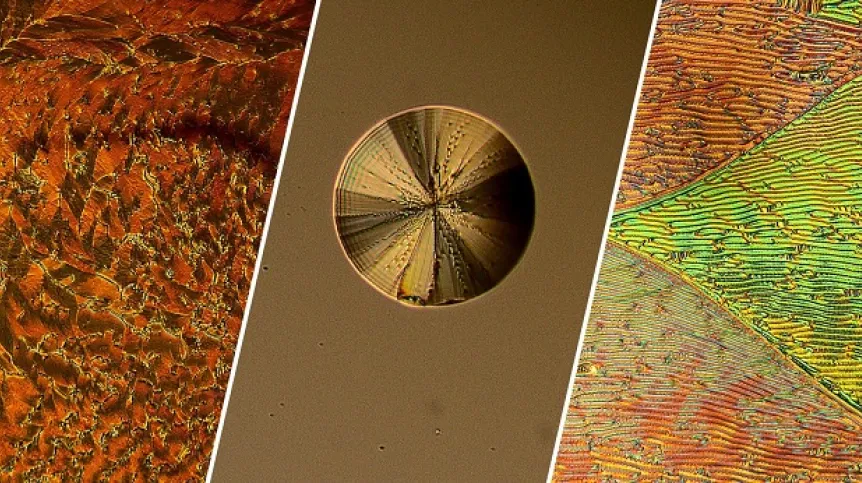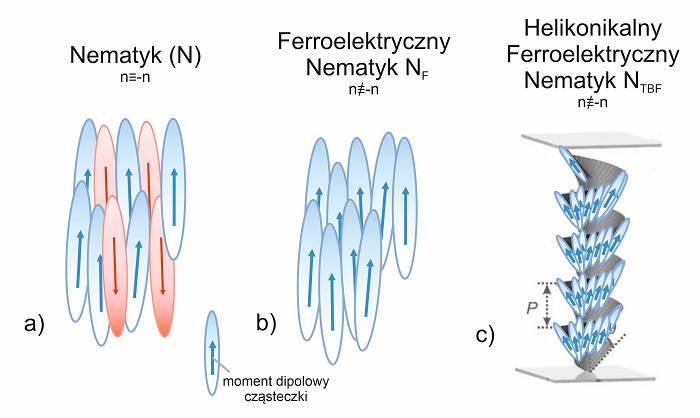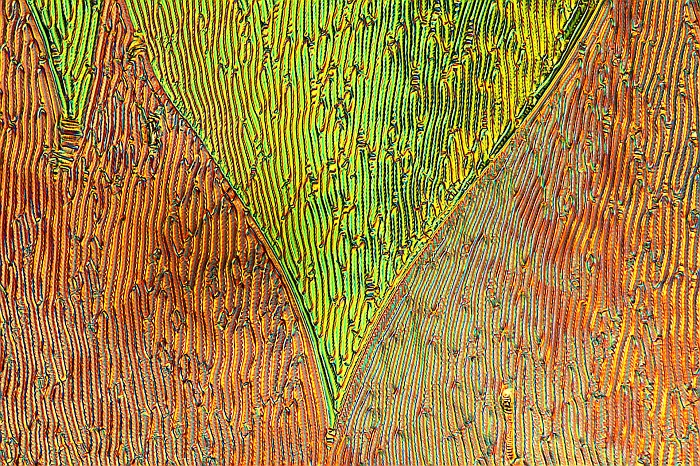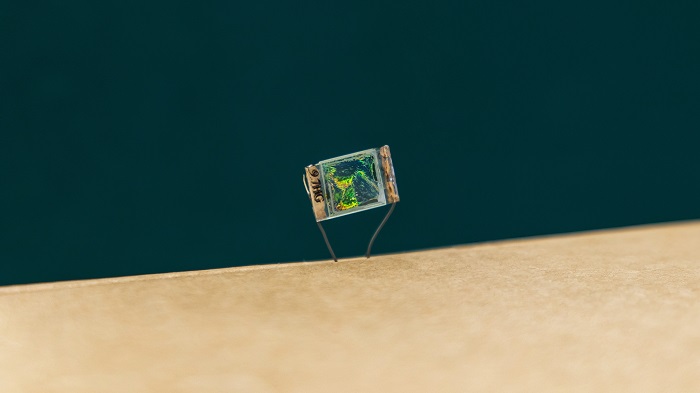
The discovery of a new way of ordering liquid crystals changes the understanding of organic matter. It can be used, among others, in fluid physics, liquid crystal materials, organic electronics, photonics and molecular biology.
The results of research on the new nematic phase of liquid crystals - discovered by scientists from the Military University of Technology (WAT) and the University of Warsaw (UW) - were published in Science.
The scientists found that molecules in liquid crystals can arrange themselves in a spiral (helix) even when they are are non-superimposable on their mirror images. The ferroelectric arrangement gives this screw structure macroscopic polarity and makes it easy to control - with a weak electric field - the structure's parameters, including optical properties, for example, colour.

THESE MOLECULES ALSO FORM HELICES
A team of scientists from the Military University of Technology and the University of Warsaw discovered a new way of helical ordering of electric dipoles in a ferroelectric liquid. The newly developed material is a heliconical, ferroelectric nematic state of matter. Here, non-chiral, relatively simple organic molecules spontaneously organize into complex, micrometre-sized screw-like structures. The new nematic phase is therefore characterized by spontaneous breaking of chiral symmetry.
As the researchers explain in the University of Warsaw press release, helices are structures commonly found in nature and their most famous example is a double helix of DNA. Most such structures are formed by low-symmetry molecules, i.e. chiral molecules that are non-superimposable on their mirror images.
Slectric dipoles are systems of spatially separated positive and negative charges. Although the majority of molecules have a dipole moment, they only occasionally form crystalline networks in which the dipoles are aligned in one direction, creating a ferroelectric phase. Until recently, it was widely believed that in liquids, dipole interactions were too weak compared to the energy of thermal motion to maintain such ordering.
The discovery that non-chiral molecules (superimposable on their mirror images) in such ferroelectric liquid spontaneously arrange themselves into helices is entirely extraordinary. The pitch of these helices is comparable to the wavelength of visible light, causing selective colours of light to be reflected by the helical structure.

PHOTONICS, LIQUID CRYSTALS, OR MAYBE AN EXPLANATION OF THE ORIGINS OF LIFE?
The research team combined two surprising properties in a liquid phase - the spontaneous formation of helices from non-chiral molecules and the ferroelectric ordering of dipoles.
'The results open up new research opportunities in the field of liquid crystal materials and may lead to further innovative discoveries. This is an example of how interdisciplinary cooperation and determination can lead to results that have the potential to change our understanding of the world and influence the future of breakthrough technologies', says Col. Dr. Przemysław Kula from the Military University of Technology.
Dr. Damian Pociecha from the University of Warsaw explains that liquid crystals, often described as the fourth phase of matter, share features of liquid and crystal. Although they are frequently used in everyday devices, liquid crystals still remain a source of surprising finds within basic science. 'The discovered and described new type of liquid crystalline phase combines two fascinating phenomena: spontaneous breaking of chiral symmetry and ferroelectric ordering of electric dipoles - both in a fluid phase', says Dr. Pociecha, adding that this discovery is not only groundbreaking from the point of view of soft matter science, but also opens up possibilities for new applications, e.g. in electro-optical technologies.
'It is difficult to overestimate the importance of this discovery. It may influence the development of new technologies and materials that will be used in modern electronic and photonic devices, as well as in organic electronics and molecular biology, where understanding the breaking of chiral symmetry is crucial for explaining the molecular origins of life', says Jakub Karcz from the Faculty of New Technologies and Chemistry at the Military University of Technology, first author of the paper. Natan Rychłowicz from the same faculty adds that the discovery will have an impact on fluid physics, organic electronics, photonics and molecular biology.

MICRO SCREWS LIKE A HELICONIA FLOWER
As reported in the Military University of Technology press release, the matter previously known in the nematic phase exhibited spontaneous ordering in which electric dipoles cancelled each other on a microscopic scale - as a result of a tendency to be anti-parallel. Scientists have known this for over a century. In 2017, a new polar phase was discovered in which, thanks to unique intermolecular interactions, the molecules tended to be polarly ordered, with dipoles aligned in one direction over large areas. Further research showed that, in addition to the polar arrangement of molecules, it is possible to spontaneously twist the polar structure into a geometry resembling a heliconia flower, whose name comes from the mathematical plane, helicon - an extended helicoid.
'This type of arrangement of non-chiral rod-like molecules, which is what the newly discovered class of compounds are, is normally forbidden and reserved for chiral molecules. Our discovery is groundbreaking because we managed to combine polar features into a chiral superstructure the size of the wavelength of visible light in one non-chiral material', explains Dr. Jakub Herman from the Military University of Technology.
The collaboration between teams from the Military University of Technology and the University of Warsaw allowed for complementary confirmation of the structure and examination of the properties of the new phase. The paper 'Spontaneous chiral symmetry breaking in polar fluid - heliconical ferroelectric nematic phase' was rated as one of the most promising in this issue of Science (the recommendation can be read here). The Military University of Technology scientific team included: Jakub Karcz, Natan Rychłowicz, Dr. engineer Jakub Herman and Col. Dr. Przemysław Kula from the Faculty of New Technologies and Chemistry of the Military University of Technology. The members of Professor Ewa Górecka's team from the Faculty of Chemistry of the University of Warsaw were: Dr. Jadwiga Szydłowska, Dr. Paweł W. Majewski and Dr. Damian Pociecha.
The scientists also confirmed Max Born's theoretical hypothesis from 1916, which predicted the possibility of the existence of complex polar structures resulting from specific interactions of electric dipoles. For decades, it remained in the area of mathematical and physical speculation, increasingly doomed to oblivion due to the lack of experimental confirmation.
PAP - Science in Poland
kol/ bar/ kap/
tr. RL













